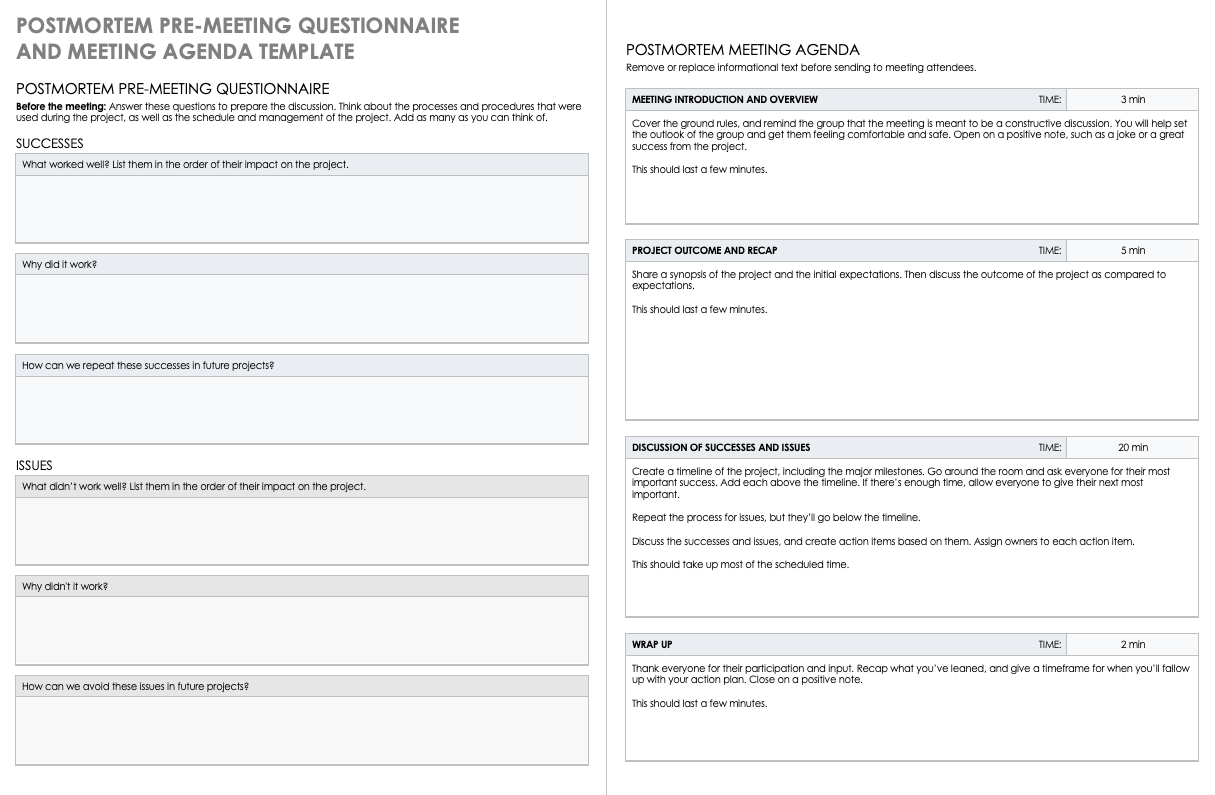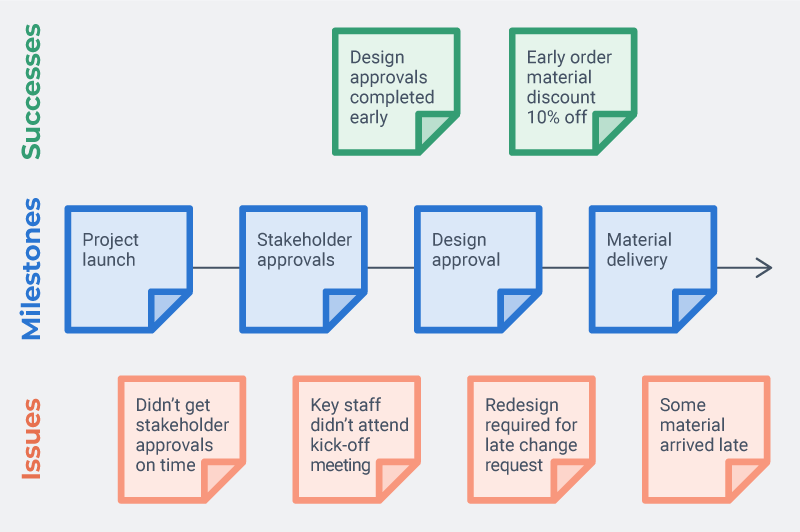What Is a Post-Mortem Meeting?
A post-mortem meeting is a formal discussion that occurs at the end of a project. In the meeting, the project team discusses what went right and wrong and uses that information to make process improvements for future projects.
All projects should include a post-mortem meeting, regardless of size or whether the project has been completed remotely. If you have a distributed team, use video conference and screen sharing technology so people in other locations can be a part of the process.
Jordan Kentris is a designer who has worked with major brands, and has led many post-mortem meetings. He says, “[A post-mortem is] really good at making sure that everyone feels heard after a project is completed, because sometimes when we're in the middle of it, we don't always get the chance to course correct.”
The IT/DevOps world has its own version of the post-mortem: After resolving an incident like a server crash or a hacker intrusion, the team reviews the cause and resolution to try to prevent the incident from recurring. (If you need to set up an incident post-mortem, check out these free downloadable templates.) Learn the difference between an incident post-mortem and a project post-mortem.
How to Prepare for a Post-Mortem
Once you’ve launched your project, it’s time to gear up for the post-mortem. Below are some key steps to take:
- Choose a moderator. You’ll need a person with leadership and conflict resolution skills, as well as someone who is familiar with the project (but not too deeply involved). The moderator will be responsible for the following:
- Sending out the agenda and questionnaire
- Keeping the meeting on track
- Settling disputes
- Pausing or stopping the meeting if the discussion escalates
- Ensuring the team follows the agenda
- Keeping the discussions constructive
- Determine your talking points. As the project manager, you should have your own thoughts on the outcome; use those ideas to create a high-level list to start constructing the agenda.
- Gather feedback from the team. Aim to get information about what they thought worked well, as well as what didn’t. Ideally, you can hold a pre-meeting discussion (this can be a 15-30 minute gathering with a whiteboard) in which you generate a list of high-level issues. If you can’t have a meeting, send out a survey. Whichever method you use, start with a few sample questions. You can use these free downloadable project post-mortem templates to guide your meeting.
- Determine the project baselines for cost, schedule, and scope. Because these factors (also known as the triple constraints) have most likely changed during the project, reference the current baselines. Use these items to decide if the project succeeded or failed in those areas. Check out our comprehensive guide to the triple constraint theory for more information.
- Create a presentation. This document should highlight the issues and successes raised in the pre-meeting discussion or survey, as well as any talking points.
- Create an agenda and send it out before the meeting. Be sure to distribute the agenda with enough time for attendees to review it, and include the following:
- The items from the pre-meeting discussion, survey, or questionaire
- A list of ground rules for the post-mortem meeting
- The talking points from your presentation
Post-Mortem Meeting Agenda
The meeting agenda will be a skeleton that you flesh out to include a comprehensive list of issues and action items. At a high-level, the agenda includes a project overview, outcome and recap, success and failures, key takeaways, and a wrap-up.
Jordan Kentris says, “When you're setting the agenda, be really clear about the expectations for everyone, and make sure that the team is aligned on the agenda and [that they] understand that [they] are coming to it in order to build actionable solutions.”
Post-Mortem Meeting Agenda Template
Use this free template to create an agenda for your project post-mortem meeting. The template will guide you through opening the meeting, discussing the project’s successes and issues, creating and assigning action items, and wrapping up the meeting. Use the included pre-meeting questionnaire to help the attendees prepare their input.
Download Post-Mortem Meeting Agenda Template
Word | Excel | Smartsheet | PDF
Check out these other post-mortem meeting-related templates, all of which are available for free download.
Ground Rules for Post-Mortem Meetings
To ensure a productive post-mortem, set and follow ground rules that encourage open and honest discussion, give everyone an opportunity to participate, and help the team address critical issues first. Below are some examples of common ways to run a post-mortem:
- Set expectations. The meeting organizer should set these ground rules for the meeting attendees. The following ideas will help encourage discussion:
- Let everyone know the meeting is a safe zone, so nothing said during it will affect anyone’s job. This gives participants the freedom and security to talk about issues that may rankle others.
- Don’t get personal — instead, focus on issues with processes rather than with people. Consider using the blameless post-mortem format.
- Treat the issues that the team exposes as opportunities to learn, which can then be used to make positive changes.
- The meeting leader should model the behaviors they want the attendees to follow.
- No arguing during the meeting. This tactic contributes to building a safe, respectful environment in which all attendees feel heard and valued. If you permit arguing, it’s likely that some people will keep their thoughts to themselves to avoid confrontation.
- Pause or stop the meeting if things get out of hand. This responsibility lies with the meeting leader, who should feel ready to step in if an argument breaks out, or if the discussion becomes personal.
- Give everyone the chance to speak.
This will encourage introverts and quiet people to participate. The moderator might pass around an item (like a talking stick) that gives the holder the exclusive right to talk. Grant Aldrich, Founder of OnlineDegree.com, advises, “I think that you should provide all of the team members with an opportunity to speak. In fact, make it mandatory.” - Each person should have a limited time to speak. A time limit forces attendees to address their most important items (the moderator can set a timer to enforce this rule). Grant Aldrich adds, “People are only given the floor for a certain amount of time; it helps [people] be respectful of everyone else's time, and forces the person to really think about the most important things that they're going to bring up.”
- All feedback should be constructive, specific, and actionable. For example, rather than saying, “Jack made us miss our deadline,” (which is not constructive, specific, or actionable), it would be better to say, “If Jack had access to the supplier delivery schedule, he could have made sure that we had room in the warehouse for the materials as they arrived, and we wouldn’t have to store them off site.” As Aldrich says, “Keep it incredibly constructive and all about what happened, why it happened, and how we are going to make the improvements so that this doesn't happen again.”
How to Conduct a Post-Mortem Meeting
In a post-mortem meeting, you need to find a balance between following the agenda and allowing space for unexpected but fruitful threads. Provide an opportunity for everyone to speak (without letting a few dominate conversation), and afford enough time to be productive without droning on too long.
- Schedule the post-mortem when you start the project. Post-mortems should be part of the project plan from the beginning, so the project team members will know to record their successes and failures (and related project data) as they occur.
- Set a meeting time-limit. There are a couple schools of thought about the ideal length for a post-mortem meeting:
- At Least 90 Minutes: This time period can give everyone time to speak, and allows for an in-depth discussion of ideas. On the negative side, long meetings can be tedious or be perceived as a waste of time.
- Thirty Minutes: This format will force people to discuss only the most critical items and keep them focused. However, such a short meeting means there’s not enough time to discuss all key issues or explore resolutions.
- Compile a guest list. There are also many opinions on the ideal size of a post-mortem meeting. Smaller meetings (e.g., five to 10 attendees) can be more focused, but limit participation to key people (which may be difficult in the case of larger projects). For larger projects, it might make sense to have a series of smaller meetings, and then a final presentation or lessons learned.
- Assign a notetaker. Pick someone (not involved in the project) to keep track of the discussion and action items. It’s also a smart idea to record the meeting to reference when creating meeting notes.
- Start the meeting with an introduction. Cover the ground rules, and remind the group that the meeting is meant to be a constructive discussion. The moderator will set the outlook of the group and help them feel comfortable and safe. Open on a positive note, such as a joke or mention a great success from the project. This should last a few minutes.
- Create a timeline of milestones.
Recap the high-level outcome of the project and the initial expectations. Then, create a timeline of the project with major milestones: This will be the core of the meeting (note that you will create a visual representation of the project). Paula Cizek, Chief Research Officer at nobl.io, an organizational design firm, says, “The first thing to do is to generate milestones. This could be anything from official project milestones and deliverables, like signing contracts, to delivering the new product. It could also include more informal or social events, such as a team happy hour.” Include dates on each milestone.
Go around the room and ask everyone for their most important success. Add each above the timeline. Repeat the process for issues and add them below the timeline.
Cizek suggests, “Have people silently reflect and jot down what went well, focusing on just the positives connected to each of these milestones. Ask them to be specific. It doesn't help to say, ‘great meeting.’ How do I repeat a great meeting? What made it great? Have people really specify what worked well and why, and then have them map it to the timeline.” - Start listing action items. Each success and issue should generate at least one action item. Assign an owner to each action item; this person will be responsible for following that action item to closure. “Before you leave the meeting, identify individuals who are responsible for making sure the policy is incorporated into existing processes,” adds Cizek.
- Explore the issues. At this point, you should be at the crux of the meeting, where you’re delving into what went wrong, what went right, and what you should do differently on future projects. The meeting leader should ask both quantitative and qualitative questions to help the team dig deeper into each success or issue.
- Quantitative Questions: These questions seek a set response (e.g., yes or no) or a selection from a list of choices. They are closed-ended questions, such as the following:
- Was your portion of the project successful?
- Rate the success of the procurement process on a scale of 1 to 5.
- Was the schedule realistic for you to meet the majority of your deadlines?
- Qualitiatvie Questions: This type of question requires some analysis or subjective responses. They are also called open-ended questions, such as the following:
- What made your portion of the project successful?
- How can we improve the procurement process?
- What could be done differently on the next project schedule to make sure you can meet the deadlines?
This discussion should also bring up root causes. They usually fall into one of the following three general categories, which may be helpful when assigning action item owners:
- Process: Something is amiss with the organization’s processes. For example, lines of communication may need to be changed or the procurement process may need to be restructured.
- Project: There was a problem with the management or execution of the project, such as incorrectly estimating the cost or timeline, or not managing change control.
- People: A team member made an error, like missing a deadline or not following correct process steps.
- Quantitative Questions: These questions seek a set response (e.g., yes or no) or a selection from a list of choices. They are closed-ended questions, such as the following:
- Close the meeting. Thank everyone for their participation and input. Spend a few minutes recapping what you’ve learned, and give a timeframe for when you’ll follow up with your action plan. End on a positive note, such as calling out a handful of successes, or reminding the team of the positive impacts the project will have on your business.
Grant Aldrich adds, “In our organization, we don't leave the room without a list of actionable items that individually we're going to do better as a team, and that is agreed upon by all the participants in the room.” - Share the post-mortem meeting notes. Everyone in the meeting should get a copy of the notes, which should include the following:
- A summary of each problem and each success
- An analysis of the root cause for each problem
- The steps that were taken to diagnose each problem and success, what assessments were made, and the steps taken to resolve each
- A timeline of each problem and success
- Lessons learned
- A list of the action items and who is responsible for each
You’ll also need to figure out a way to prioritize the action items. There are many ways to do this, including the MoSCoW method, which puts action items into the following buckets:
- Must Have: Critical items that need to be addressed immediately
- Should Have: Important items that will add significant value to the organization
- Could Have: Nice-to-have items that will have a small impact
- Won't Have: Low-priority or low-impact items that don’t need to be addressed any time soon
Regardless of which prioritization scheme you use, look for quick wins: changes that can be made with little effort but that will have an immediate positive impact.
Tips for Running Effective Post-Mortem Meetings
Well-run post-mortems can yield constructive and actionable information that can have positive effects on future projects. Here are some tips for making these meetings more fruitful.
- Implement the changes. Once the meeting is over, begin making the changes discussed. Review the meeting notes and use them to create an action plan that includes the following sections:
- A prioritized list of the action items and their owners. You can use a process, such as the MoSCoW method (described above), to sort the items. You can also look for commonalities in the action items and combine them to reduce the amount of effort required.
- A table to track each action item’s status and when the team learned of its completion.
- Plans for sending communication sent to other parts of the company that would benefit from the lessons learned.
- Keep the meeting fun. The topics covered can be negative. Sprinkling in the occasional joke can cut the tension and make those discussions less painful.
- Keep it positive. Most of the meeting will be about things that went wrong, so remind everyone that a lot went right, too.
- Remember that it’s a discussion, not a lecture. As the project manager, you have a lot to say, but so does your team. Having an in-depth discussion of each issue can help unearth better potential solutions.
- Avoid personal disagreements. The goal of the meeting is to explore how to improve processes. As the saying goes, “It’s not personal, it’s business.”
- Promote good behavior. It’s up to the moderator to set the tone and remind everyone to be honest and respectful. Similarly, if the discussion gets unruly or goes off track, they need to step in and keep the meeting on point.
- Keep laptops out of the room (the notetaker gets a pass). Limiting the amount of distractions in a meeting will help attendees stay focused on the discussion. You may also consider having a similar rule about phones.
- Mind the time zones. If you have a distributed team, be aware of everyone’s working hours and schedule the meeting when everyone can make it during their working hours. For more information on communicating with remote teams, read “How to Implement Remote Team Communication Strategies for Your Business: Best Practices and Expert Tips.”
Streamline Post-Mortem Meetings with Smartsheet for Project Management
Empower your people to go above and beyond with a flexible platform designed to match the needs of your team — and adapt as those needs change.
The Smartsheet platform makes it easy to plan, capture, manage, and report on work from anywhere, helping your team be more effective and get more done. Report on key metrics and get real-time visibility into work as it happens with roll-up reports, dashboards, and automated workflows built to keep your team connected and informed.
When teams have clarity into the work getting done, there’s no telling how much more they can accomplish in the same amount of time. Try Smartsheet for free, today.




